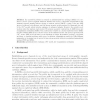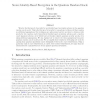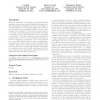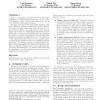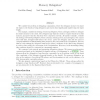EUROCRYPT
2012
Springer
12 years 7 months ago
2012
Springer
We provide an alternative method for constructing lattice-based digital signatures which does not use the “hash-and-sign” methodology of Gentry, Peikert, and Vaikuntanathan (ST...
EUROCRYPT
2012
Springer
12 years 7 months ago
2012
Springer
We describe a compression technique that reduces the public key size of van Dijk, Gentry, Halevi and Vaikuntanathan’s (DGHV) fully homomorphic scheme over the integers from ˜O(�...
PKC
2012
Springer
12 years 7 months ago
2012
Springer
ded abstract of this work will appear in Public Key Cryptography — PKC 2012. This is the full version. We propose a general framework that converts (ordinary) signature schemes ...
PKC
2012
Springer
12 years 7 months ago
2012
Springer
Abstract. In the standard setting of broadcast encryption, information about the receivers is transmitted as part of the ciphertext. In several broadcast scenarios, however, the id...
PKC
2012
Springer
12 years 7 months ago
2012
Springer
Abstract. An unresolved problem in research on authenticated key exchange (AKE) is to construct a secure protocol against advanced attacks such as key compromise impersonation and ...
CRYPTO
2012
Springer
12 years 7 months ago
2012
Springer
We give the first proof of security for an identity-based encryption scheme in the quantum random oracle model. This is the first proof of security for any scheme in this model ...
TCC
2012
Springer
13 years 18 days ago
2012
Springer
The hash-and-sign RSA signature is one of the most elegant and well known signatures schemes, extensively used in a wide variety of cryptographic applications. Unfortunately, the o...
IACR
2011
13 years 4 months ago
2011
Although malleability is undesirable in traditional digital signatures, schemes with limited malleability properties enable interesting functionalities that may be impossible to o...
IACR
2011
13 years 4 months ago
2011
Companies, organizations, and individuals often wish to share information to realize valuable social and economic goals. Unfortunately, privacy concerns often stand in the way of ...
CRYPTO
2011
Springer
13 years 4 months ago
2011
Springer
We consider the problem of delegating computation, where the delegator doesn’t even know the input to the function being delegated, and runs in time significantly smaller than ...

